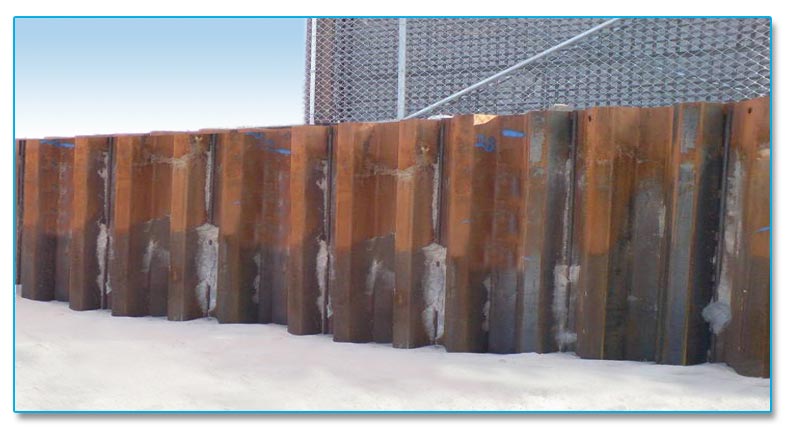02 SHORING
Shoring
Shoring System
Foundation Pile driving installs driven sheet pile and soldier pile-lagging shoring systems as well as ground water cutoff walls and geo-containment systems. We provide pricing on designed shoring systems, and also provide full design-build shoring services. We understand that the selection of the correct shoring system has an effect on the project as a whole, and that the most cost-effective shoring system alone may not always produce the lowest cost to the project.Our crews consist of certified welders to ensure that waler and struts are installed correctly. When walers are required, we can help examine all alternatives from internally braced walers, to staged raker construction, to helical anchor tiebacks. We ask the right questions and work with you to determine the best system for the project. We also work with grading and dewatering subcontractors to put a complete shored-excavation project together.Vinyl sheetpiles have seen recent expansion in use, as they are used as landscape wall retaining systems or as ground water cutoff walls, or as the core of dykes and levees. Driven vinyl sheets require a different approach and an expertise unlike steel sheets, and we have successfully completed many of these unique projects. Our Fundex equipment is used for slurry-cement cutoff walls, which offer near complete ground water cutoff for shored excavation or ground water containment for hazardous sites. Call us for help in selecting the appropriate shoring system for your project. We are always pleased to assist in design development, staging, planning and budgetary estimates as well.

Sheet Piling
Sheet piles are panels with interlocking connections, driven into the ground with either an impact or vibratory hammer. Sheet piling is rarely part of the permanent structure but provide structural resistance in deep excavations. Although steel sheet pile walls have been proven to be effective, newer materials such as vinyl, plastic, recast concrete and fiberglass have proven to be as effective and often less expensive. Sheet piles are long structural sections with a vertical interlocking system that creates a continuous wall. The walls are most often used to retain either soil or water. The ability of a sheet pile section to perform is dependent upon its geometry and the soils it is driven into. The pile transfers pressure from the high side of the wall to the soil in front of the wall.There are permanent and temporary applications. Permanent sheet piles remain in the ground and serve as permanent retaining structures. Temporary sheet piles are designed to provide safe access for construction, and are then removed. Hot rolled and cold formed are two primary methods of manufacturing sheet pile. While there are key differences between these two methods, the most important distinction is the interlock. Since hot rolled sheet piles are produced from steel at high temperatures, the interlock tends to be tighter than its cold formed counterpart. Normally, looser interlocks are not recommended in extremely hard driving conditions or for walls requiring low permeability. Hot rolled sheet piles are generally larger and have a broader range of strengths than cold form sheet piles, but there is a large overlap between the two, especially in the most common sizes.

Berlin Shoring Wall
Soldier pile and lagging walls are some of the oldest forms of retaining systems used in deep excavations. Soldier pile walls have successfully being used since the late 18th century in metropolitan cities like New York, Berlin, and London. The method is also commonly known as the "Berlin Wall" when steel piles and timber lagging is used. Alternatively, caissons, circular pipes, or concrete piles can also be used as soldier piles but at an increased cost. Berlin shoring walls consist of steel soldier H beams installed at regular spacing with horizontal wood or concrete lagging in-between. The designation “Berlin Wall” originates from its use for the Berlin subway prior to the Second World War.
Timber lagging is typically used although reinforced concrete panels can be also utilized for permanent conditions. Soldier pile walls are formed by:
1. Constructing soldier piles at regular intervals (6 ft to 12 ft, typical)
2. Excavating in small stages and installing lagging.
3. Backfilling and compacting the void space behind the lagging.
The major advantages of soldier pile walls are:
1. Soldier piles are fast to construct.
2. Soldier pile construction is cheaper when compared to other systems.
3. Soldier pile installation is versatile and adjustments can be made in the field easily to accomodate changes.
4. Lagging construction can be very quick.
5. Construction of soldier pile and lagging walls does not require very advanced construction techniques.